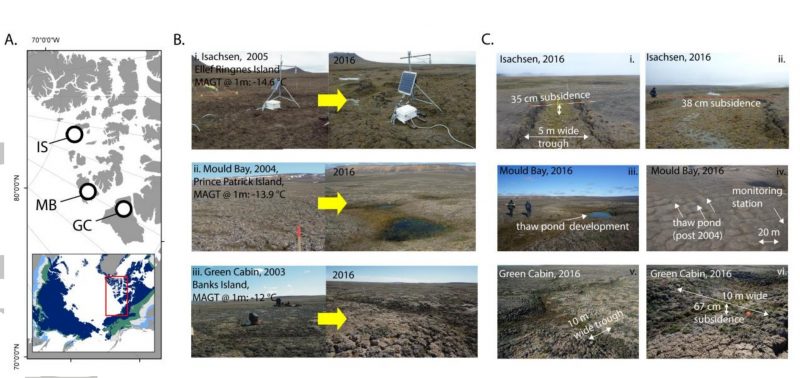26 June 2019
Climate change is transforming northernmost Arctic landscapes
Posted by larryohanlon
By Joshua Learn
Isachsen, a permafrost monitoring site that sits at a latitude of 78 degrees north on the Arctic Canadian island of Ellef Ringnes, seemed like the last place that would feel the effects of climate change. But a new study in the AGU journal Geophysical Research Letters shows warmer-than-usual periods are causing frozen ground to thaw earlier than scientists expected.
Isachsen is extremely remote and plagued by unpredictable weather, so researchers struggle to get there with any regularity. It is a two-hour flight from the nearest weather station at Prince Patrick Island, and researchers trying to make the extra jump between the islands have to carry enough fuel for two attempts since the chances of weather being clear enough to land on Ellef Ringnes are slim.

A. Map of the study area showing permafrost monitoring site locations. B. Examples of the even terrain at each site at the start of monitoring (2003, 2004, 2005) and the terrain after a decade of monitoring (2016). Thermokarst development was observed at all sites. C. Examples of thermokarst topography and landforms observed at each site in 2016: i), ii) subsidence and trough formation at Isachsen, iii) trough formation and pond development at Mould Bay, iv) subsidence and trough formation at Green Cabin. All images are taken from within 500 m of the permafrost monitoring station with the exception of iv which was taken aerially but includes the monitoring station within the frame. Credit: AGU
In 2006, researchers from the Geophysical Institute Permafrost Lab at the University of Alaska Fairbanks reached the island. The landscape around the site at Isachsen and two other monitoring stations on Banks and Prince Patrick islands was flat, with little topography. The researchers were not able to return to Isachsen until 2013.
“In 2013 the landscape was completely different, and that’s when we got excited,” said Vladimir Romanovsky, a geophysicist at the Geophysical Institute Permafrost Lab at the University of Alaska Fairbanks.
The landscape at Isachsen had gone from basically flat to a hummock-filled landscape full of meltwater ponds generally referred to as thermokarst – the topography formed from the thawing of ice-rich permafrost and melt of ground ice.
“The system is already undergoing changes that were projected to occur in many decades,” said Louise Farquharson, a postdoctoral researcher at the Geophysical Institute Permafrost Lab at the University of Alaska Fairbanks and the lead author of the new study.
Permafrost is a wide term that refers to ground that remains below freezing for two or more years. Permafrost isn’t always rich in ice, but when ice-rich permafrost thaws, the landscape can take on a varied topographic appearance made up of hummocks and water hollows formed through the melting of this ice.
Thawing of permafrost and the accompanying landscape changes it prompts are common thousands of miles to the south of Isachsen where ground that formerly stayed cold enough year-round is now thawing due to longer, hotter summers. But many researchers commonly believed the northern reaches were still immune to the warming effects of climate change.
“This brings cold permafrost to the story basically,” Farquharson said of the new research.
Equipment installed at Isachsen and other northern monitoring sites in 2003 revealed that since 2006 the area had been subjected to summer temperatures 200 to 300 percent higher than anything researchers had recorded going back to the 1970s, when temperatures from regional stations began recording the weather, Farquharson said.
Researchers were surprised by how quickly the landscape changes occurred.
“Just a few warm summers can change everything,” Romanovksy said. “We were very lucky because we just set up everything and it just happened before our eyes.”
The permafrost beneath the thermokarst terrain at the High-Arctic sites is still thermally stable at about -15 degrees Celsius (5 degrees Fahrenheit), and Romanovsky said the area is still a long way from thawing like permafrost farther south, but the physical changes show that a few warm summers in a row can have a huge transformative effect on ice close to the surface.
He said that while there isn’t much human infrastructure in the area, this type of understudied change to the topography could affect oil pipelines in Alaska or other human infrastructure formerly believed to be outside the reach of the current effects of climate change.
Farquharson said the thawing of permafrost can result in the release of more carbon into the atmosphere, accelerating climate change. The release of sediments within the permafrost can also have transformative effects on the way waterways flow in the area, which could have far-reaching ecological consequences for the wildlife and vegetation in the region.
“It basically completely changes the habitat. You’re going from a very dry level surface to something that is covered in thermokarst with ponds popping up,” Farquharson said, adding that this may provide benefits for some species like water birds but negative impacts to other wildlife.
— Joshua Learn (@JoshuaLearn1) is a freelance science writer.


 GeoSpace is a blog on Earth and space science, managed by AGU’s Public Information staff. The blog features posts by AGU writers and guest contributors on all sorts of relevant science topics, but with a focus on new research and geo and space sciences-related stories that are currently in the news.
GeoSpace is a blog on Earth and space science, managed by AGU’s Public Information staff. The blog features posts by AGU writers and guest contributors on all sorts of relevant science topics, but with a focus on new research and geo and space sciences-related stories that are currently in the news.